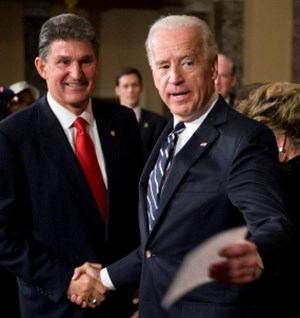Biden approves funding for carbon capture programs using enhanced oil recovery
(Bloomberg) —The Biden administration has reversed course on a carbon capture funding program to allow oil production following an intervention by senators including Joe Manchin and Kyrsten Sinema, handing a win to the fossil fuel industry.
The Department of Energy announced $3.7 billion of funding to back projects that remove carbon dioxide from the atmosphere, which have long been considered key technologies needed to reach net-zero goals.
But in a policy pivot, the programs now open the door to the use of taxpayer dollars to fund carbon capture projects that produce fossil fuels through a process known as enhanced oil recovery, or EOR.
It’s a significant shift and one likely to be championed by the oil and gas industry because it promises more funding options for crude production. The move is also another example of how the Biden administration has been caught between competing interests as it pushes a climate agenda while trying to increase energy supplies in order to tame gasoline prices.
The EOR process involves the injection of CO2 into old oil and gas fields to squeeze out more crude. Advocates say burying the CO2 helps reduce the oil’s carbon footprint and provides a critical revenue stream for related projects such as Direct Air Capture (DAC), a nascent technology that pulls the climate-warming gas out of the atmosphere.
Critics argue that the crude produced through EOR negates any climate benefit and helps prolong the long-term use of fossil fuels.
The carbon capture projects will be required to complete an in-depth environmental pollution impact assessment prior to construction and an assessment of net-climate benefits will be required during the operation phase, the Energy Department said in its funding opportunity announcement.
Applicants “should detail plans for maximizing the amount of CO2 storage relative to associated hydrocarbon extraction over the life of the project,” the department said.
Letter From Manchin
Earlier this year, the Department of Energy notified the industry of its intent to provide funding for DAC projects, but specifically said that projects that produce oil and gas “will not be accepted.”
The department decided to change that stance after a July letter in which Manchin, Sinema and other lawmakers from both sides of the aisle said they were concerned it wouldn’t be implemented as Congress intended, according to a person familiar with the matter.
Project developers “should not be subject to requirements that would limit the revenue” derived from pumping CO2 underground, 10 senators wrote in the letter. Widening the revenue streams would “provide the flexibility that private developers need to gain value from investment in DAC, including to deploy first-of-its-kind technology at scale.”
Maximizing’ Emissions Reductions
“Rather than exclude specific geologic storage options, DOE will prioritize direct air capture demonstration projects that meet the legislative requirement of capturing and removing one million tons of carbon dioxide (CO2) per year or more from the atmosphere, while maximizing greenhouse gas emissions reductions and providing significant environmental, economic, and workforce benefits for communities,” Crabtree said in an emailed statement to Bloomberg.
“At this time, leading developers of direct air capture projects are seeking to store their CO2 in saline geologic formations in response to interest from investors and project partners,” he said in the statement.
For environmentalists, subsidizing oil and gas production is a fundamental strategic flaw in the policy.
“The fossil fuel industry’s access to climate policy-making is what has delayed and constrained action up to this point,” said John Noel, a senior campaigner with Greenpeace USA.
“Giving oil producers access to a consistent and subsidized source of carbon dioxide that they can plow into the ground to keep oil oilfields alive is a recipe for disaster and keeps us further away from the Biden administration’s emissions goals.”



